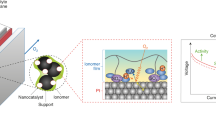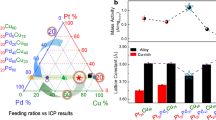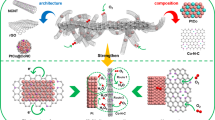Abstract
Low-temperature fuel cells are limited by the oxygen reduction reaction, and their widespread implementation in automotive vehicles is hindered by the cost of platinum, currently the best-known catalyst for reducing oxygen in terms of both activity and stability. One solution is to decrease the amount of platinum required, for example by alloying, but without detrimentally affecting its properties. The alloy PtxY is known to be active and stable, but its synthesis in nanoparticulate form has proved challenging, which limits its further study. Herein we demonstrate the synthesis, characterization and catalyst testing of model PtxY nanoparticles prepared through the gas-aggregation technique. The catalysts reported here are highly active, with a mass activity of up to 3.05 A mgPt−1 at 0.9 V versus a reversible hydrogen electrode. Using a variety of characterization techniques, we show that the enhanced activity of PtxY over elemental platinum results exclusively from a compressive strain exerted on the platinum surface atoms by the alloy core.
This is a preview of subscription content, access via your institution
Access options
Subscribe to this journal
Receive 12 print issues and online access
$259.00 per year
only $21.58 per issue
Buy this article
- Purchase on Springer Link
- Instant access to full article PDF
Prices may be subject to local taxes which are calculated during checkout





Similar content being viewed by others
References
Gasteiger, H. A., Kocha, S. S., Sompalli, B. & Wagner, F. T. Activity benchmarks and requirements for Pt, Pt-alloy, and non-Pt oxygen reduction catalysts for PEMFCs. Appl. Catal. B 56, 9–35 (2005).
Gasteiger, H. A. & Markovic, N. M. Just a dream – or future reality? Science 324, 48–49 (2009).
Stephens, I. E. L., Bondarenko, A. S., Grønbjerg, U., Rossmeisl, J. & Chorkendorff, I. Understanding the oxygen reduction reaction on platinum and its alloys. Energy Environ. Sci. 5, 6744–6762 (2012).
Debe, M. K. Electrocatalyst approaches and challenges for automotive fuel cells. Nature 486, 43–51 (2012).
Wagner, F. T., Lakshmanan, B. & Mathias, M. F. Electrochemistry and the future of the automobile. J. Phys. Chem. Lett. 1, 2204–2219 (2010).
Chen, S., Gasteiger, H. A., Hayakawa, K., Tada, T. & Shao-Horn, Y. Platinum-alloy cathode catalyst degradation in proton exchange membrane fuel cells: nanometer-scale compositional and morphological changes. J. Electrochem. Soc. 157, A82–A97 (2010).
Maillard, F. et al. Durability of Pt3Co/C nanoparticles in a proton-exchange membrane fuel cell: direct evidence of bulk Co segregation to the surface. Electrochem. Commun. 12, 1161–1164 (2010).
Cui, C. H., Gan, L., Heggen, M., Rudi, S. & Strasser, P. Compositional segregation in shaped Pt alloy nanoparticles and their structural behaviour during electrocatalysis. Nature Mater. 12, 765–771 (2013).
Wang, D. L. et al. Structurally ordered intermetallic platinum–cobalt core–shell nanoparticles with enhanced activity and stability as oxygen reduction electrocatalysts. Nature Mater. 12, 81–87 (2013).
Liu, W. et al. Bimetallic aerogels: high-performance electrocatalysts for the oxygen reduction reaction. Angew. Chem. Int. Ed. 52, 9849–9852 (2013).
Sasaki, K. et al. Highly stable Pt monolayer on PdAu nanoparticle electrocatalysts for the oxygen reduction reaction. Nature Commun. 3, 1115 (2012).
Wang, C. et al. Design and synthesis of bimetallic electrocatalyst with multilayered Pt-skin surfaces. J. Am. Chem. Soc. 133, 14396–14403 (2011).
Greeley, J. et al. Alloys of platinum and early transition metals as oxygen reduction electrocatalysts. Nature Chem. 1, 552–556 (2009).
Stamenkovic, V. R. et al. Improved oxygen reduction activity on Pt3Ni(111) via increased surface site availability. Science 315, 493–497 (2007).
Stephens, I. E. L., Bondarenko, A. S., Bech, L. & Chorkendorff, I. Oxygen electroreduction activity and X-ray photoelectron spectroscopy of alloys of platinum and early transition metals. ChemCatChem 4, 341–349 (2012).
Escudero-Escribano, M. et al. Pt5Gd as a highly active and stable catalyst for oxygen electroreduction. J. Am. Chem. Soc. 134, 16476–16479 (2012).
Johannesson, G. H. et al. Combined electronic structure and evolutionary search approach to materials design. Phys. Rev. Lett. 88, 255506 (2002).
Jong Yoo, S. et al. Enhanced stability and activity of Pt–Y alloy catalysts for electrocatalytic oxygen reduction. Chem. Commun. 47, 11414–11416 (2011).
Hwang, S. J. et al. Role of electronic perturbation in stability and activity of Pt-based alloy nanocatalysts for oxygen reduction. J. Am. Chem. Soc. 134, 19508–19511 (2012).
Sanchez Casalongue, H. et al. Direct observation of the oxygenated species during oxygen reduction on a platinum fuel cell cathode. Nature Commun. 4, 2817 (2013).
Toda, T., Igarashi, H., Uchida, H. & Watanabe, M. Enhancement of the electroreduction of oxygen on Pt alloys with Fe, Ni, and Co. J. Electrochem. Soc. 146, 3750–3756 (1999).
Stamenkovic, V. R., Mun, B. S., Mayrhofer, K. J. J., Ross, P. N. & Markovic, N. M. Effect of surface composition on electronic structure, stability, and electrocatalytic properties of Pt–transition metal alloys: Pt-skin versus Pt-skeleton surfaces. J. Am. Chem. Soc. 128, 8813–8819 (2006).
Yang, R. Z., Strasser, P. & Toney, M. F. Dealloying of Cu3Pt (111) studied by surface X-ray scattering. J. Phys. Chem. C 115, 9074–9080 (2011).
Stephens, I. E. L. et al. Tuning the activity of Pt(111) for oxygen electroreduction by subsurface alloying. J. Am. Chem. Soc. 133, 5485–5491 (2011).
Strasser, P. et al. Lattice-strain control of the activity in dealloyed core–shell fuel cell catalysts. Nature Chem. 2, 454–460 (2010).
Johansson, T. et al. Pt skin versus Pt skeleton structures of Pt3Sc as electrocatalysts for oxygen reduction. Top. Catal. 57, 245–254 (2014).
Nørskov, J. K. et al. Origin of the overpotential for oxygen reduction at a fuel-cell cathode. J. Phys. Chem. B 108, 17886–17892 (2004).
Kitchin, J. R., Nørskov, J. K., Barteau, M. A. & Chen, J. G. Role of strain and ligand effects in the modification of the electronic and chemical properties of bimetallic surfaces. Phys. Rev. Lett. 93, 156801 (2004).
Calle-Vallejo, F., Martinez, J. I., Garcia-Lastra, J. M., Rossmeisl, J. & Koper, M. T. M. Physical and chemical nature of the scaling relations between adsorption energies of atoms on metal surfaces. Phys. Rev. Lett. 108, 116103 (2012).
Mavrikakis, M., Hammer, B. & Nørskov, J. K. Effect of strain on the reactivity of metal surfaces. Phys. Rev. Lett. 81, 2819–2822 (1998).
Cordero, B. et al. Covalent radii revisited. Dalton Trans. 2832–2838 (2008).
Pourbaix, M. Atlas of Electrochemical Equilibria in Aqueous Solutions 2nd edn (National Association of Corrosion Engineers, 1974).
Nishanth, K. G., Sridhar, P. & Pitchumani, S. Enhanced oxygen reduction reaction activity through spillover effect by Pt–Y(OH)3/C catalyst in direct methanol fuel cells. Electrochem. Commun. 13, 1465–1468 (2011).
Jeon, M. K. & McGinn, P. J. Carbon supported Pt–Y electrocatalysts for the oxygen reduction reaction. J. Power Sources 196, 1127–1131 (2011).
Luczak, F. J. & Landsman, D. A. Fuel cell cathode catalyst alloy-comprising noble metal, cobalt and a transition metal. US patent 4677092-A (1987).
Mukerjee, S. & Srinivasan, S. Enhanced electrocatalysis of oxygen reduction on platinum alloys in proton-exchange membrane fuel-cells. J. Electroanal. Chem. 357, 201–224 (1993).
van der Vliet, D. F. et al. Mesostructured thin films as electrocatalysts with tunable composition and surface morphology. Nature Mater. 11, 1051–1058 (2012).
Snyder, J., Fujita, T., Chen, M. W. & Erlebacher, J. Oxygen reduction in nanoporous metal–ionic liquid composite electrocatalysts. Nature Mater. 9, 904–907 (2010).
Nesselberger, M. et al. The effect of particle proximity on the oxygen reduction rate of size-selected platinum clusters. Nature Mater. 12, 919–924 (2013).
Perez-Alonso, F. J. et al. The effect of size on the oxygen electroreduction activity of mass-selected platinum nanoparticles. Angew. Chem. Int. Ed. 51, 4641–4643 (2012).
Li, Z. Y. et al. Structures and optical properties of 4–5 nm bimetallic AgAu nanoparticles. Faraday Discuss. 138, 363–373 (2008).
Yin, F., Wang, Z. W. & Palmer, R. E. Controlled formation of mass-selected Cu–Au core–shell cluster beams. J. Am. Chem. Soc. 133, 10325–10327 (2011).
Von Issendorff, B. & Palmer, R. E. A new high transmission infinite range mass selector for cluster and nanoparticle beams. Rev. Sci. Instrum. 70, 4497–4501 (1999).
Li, D. G. et al. Surfactant removal for colloidal nanoparticles from solution synthesis: the effect on catalytic performance. ACS Catal. 2, 1358–1362 (2012).
Solla-Gullon, J., Montiel, V., Aldaz, A. & Clavilier, J. Electrochemical characterisation of platinum nanoparticles prepared by microemulsion: how to clean them without loss of crystalline surface structure. J. Electroanal. Chem. 491, 69–77 (2000).
Cuenya, B. R., Baeck, S. H., Jaramillo, T. F. & McFarland, E. W. Size- and support-dependent electronic and catalytic properties of Au0/Au3+ nanoparticles synthesized from block copolymer micelles. J. Am. Chem. Soc. 125, 12928–12934 (2003).
Reichl, R. & Gaukler, K. H. An investigation of air-grown yttrium oxide and experimental determination of the sputtering yield and the inelastic mean free path. Appl. Surf. Sci. 26, 196–210 (1986).
Shao-Horn, Y. et al. Instability of supported platinum nanoparticles in low-temperature fuel cells. Top. Catal. 46, 285–305 (2007).
Choi, S. I. et al. Synthesis and characterization of 9 nm Pt–Ni octahedra with a record high activity of 3.3 A/mgPt for the oxygen reduction reaction. Nano Lett. 13, 3420–3425 (2013).
Nesselberger, M. et al. The particle size effect on the oxygen reduction activity of Pt catalysts: influence of electrolyte and relation to single crystal models. J. Am. Chem. Soc. 133, 17428–17433 (2011).
Acknowledgements
The authors gratefully acknowledge financial support from the Danish Ministry of Science's UNIK initiative, Catalysis for Sustainable Energy. The Center for Individual Nanoparticle Functionality is supported by the Danish National Research Foundation (DNRF54). The A.P. Møller and Chastine Mc-Kinney Møller Foundation is gratefully acknowledged for its contribution towards the establishment of the Centre for Electron Nanoscopy in the Technical University of Denmark. The Interdisciplinary Centre for Electron Microscopy at École Polytechnique Fédérale de Lausanne is gratefully acknowledged for the use of the FEI Tecnai Osiris TEM. Support for this work was received from the Danish Council for Strategic Research's project NACORR (12-133817) and MEDLYS (10-093906). I.E.L.S. was supported by the ForskEL programme's project CATBOOSTER (2001-1-10669). D.N.M. is the recipient of a HC Ørsted postdoctoral fellowship. Part of this work is supported by Basic Energy Sciences, US Department of through the SUNCAT Center for Interface Science and Catalysis. This research was partly carried out at the Stanford Synchrotron Radiation Lightsource, a National User Facility operated by Stanford University on behalf of the Basic Energy Sciences, US Department of Energy. We thank J. Bargar, A. Mehta, R. Davis, M. Latimer and E. J. Nelson for support with the EXAFS instrumentation and for helpful discussions.
Author information
Authors and Affiliations
Contributions
I.C. and I.E.L.S. conceived the experiments. P.H-F. performed the electrochemical experiments. F.M., D.N.M., C.E.S., P.M. and A.N. performed the UHV experiments. D.F., A.B. and A.M.W performed the XAS measurements. D.D. performed the microscopy. P.H-F. designed the figures. P.H-F. and I.E.L.S. wrote the first draft of the paper. All authors discussed the results and commented on the manuscript.
Corresponding authors
Ethics declarations
Competing interests
I.C. and I.E.L.S. have a patent on the catalyst material PtxY, PCT/DK2010/050193. The other authors declare no competing financial interests.
Supplementary information
Supplementary information
Supplementary information (PDF 1441 kb)
Rights and permissions
About this article
Cite this article
Hernandez-Fernandez, P., Masini, F., McCarthy, D. et al. Mass-selected nanoparticles of PtxY as model catalysts for oxygen electroreduction. Nature Chem 6, 732–738 (2014). https://doi.org/10.1038/nchem.2001
Received:
Accepted:
Published:
Issue Date:
DOI: https://doi.org/10.1038/nchem.2001
This article is cited by
-
Promoting ordering degree of intermetallic fuel cell catalysts by low-melting-point metal doping
Nature Communications (2023)
-
Titanium Carbide/Carbon-Supported Platinum Nanoparticles Boost Oxygen Reduction Reaction for Fuel Cells
Journal of Electronic Materials (2023)
-
Phase diagrams guide synthesis of highly ordered intermetallic electrocatalysts: separating alloying and ordering stages
Nature Communications (2022)
-
Ultrastable bimetallic Fe2Mo for efficient oxygen reduction reaction in pH-universal applications
Nano Research (2022)
-
Design concept for electrocatalysts
Nano Research (2022)



